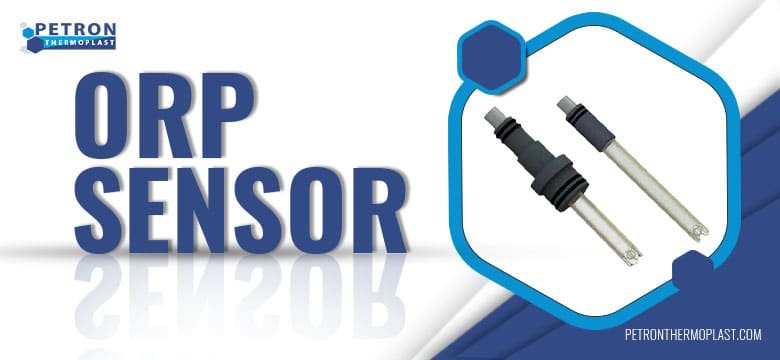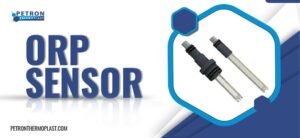ORP Sensor: Advice, Caution, and ORP Measurement Limitations
A water sample’s oxidizing or reducing potential is commonly ascertained by measuring ORP (oxidation-reduction potential, also known as redox). It suggests that there may be pollution, particularly from industrial effluent. If the user knows a specific element in the sample that is mostly accountable for the observed result, ORP can be a useful measurement. For instance, the presence of hydrogen sulfide will provide a significant negative ORP value, while excess chlorine in wastewater effluent will produce a large positive ORP value.
The potential of a chemically inert (platinum) electrode submerged in the solution is used to calculate ORP. The pH probe’s reference electrode is used to read the sensing electrode potential, which is shown in millivolts (mV). In water with a relatively high concentration of redox-active species, such as the salts of numerous metals (Fe2+, Fe3+) and potent oxidizing (chlorine) and reducing (sulfite ion) agents, the detection of ORP is particularly valuable.
As a result, ORP can occasionally be used to monitor the metallic contamination in ground or surface water or to calculate the amount of chlorine in wastewater effluent. The measured potential, however, reflects a concatenation of all the actions of all the dissolved species in the medium since ORP is a generic test. This means that unless a dominating redox-active species is known to be present, measuring ORP in reasonably clean environmental water (ground, surface, estuarine, and marine) is of limited benefit. Therefore, users should exercise caution when “over-interpreting” ORP data unless precise site-specific information is available.
ORP vs. Eh: Calibration of ORP Sensors
The distinction between ORP and Eh is a topic that many users of ORP Sensor, such as the EXO sonde, ProDSS, or ProQuatro handhelds, do field or laboratory redox measurements have issues.
In essence, the reference electrode (and resulting voltage offset) against which the potential of the platinum sensor is recorded differs between the two characteristics, which both quantify the medium’s propensity to transmit electrons. A voltage reading against the Standard Hydrogen Electrode (SHE) is what is meant by the word “Eh.” Still, the phrase “ORP” is far less precise and can refer to real-world or hypothetical reference electrodes, such as Ag/AgCl, calomel, or SHE. Redox readings are often done using either the Ag/AgCl or calomel reference electrodes, with Ag/AgCl being more common in multiparameter water quality apparatus. It is generally difficult to utilize the SHE in laboratory or field studies.
As a result, Eh is typically not known in advance. However, two methods simplify translating the voltages acquired from ORP measurements against non-SHE electrodes into Eh values.
In order to account for the fixed difference between the SHE and the other reference system, an offset voltage is added (or subtracted) to the ORP measurements obtained vs. a realistic reference electrode. For a number of useful reference electrodes, the offset voltage may be easily found in Table 2580: II of the Standard Methods on ORP section. For instance, the potential of a Zobell solution measured with 4 M KCl and the Ag/AgCl reference electrode is +228 mV, but the potential of the same solution measured with the SHE is +428 mV. So, to convert ORP values obtained under these circumstances, just increase the ORP voltage by 200 mV. For instance, Eh values of +350 and +28 mV are obtained from ORP measurements of +150 and -172 mV, respectively.
Effect of Temperature on ORP
The sensor’s voltage output will be impacted by the water’s temperature, which is used to calculate ORP. This element should unquestionably be considered when calibrating instruments and reporting field ORP results. The following table can be used for calibration when utilizing the YSI recommended standard, Zobell solution. Enter 241 mV at the calibration prompt instead of 228 mV (the generally reported 25°C value) if the Zobell calibration standard is at 15°C rather than 25°C. Similar temperature-dependence information for additional ORP standards, such as Light’s Solution and quinhydrone standards in pH buffers, may be found in the literature by the user.
ORP Electrode Cleaning
The next step will eliminate numerous typical impurities from the platinum ORP electrode. This approach may not dissolve some chemicals from contaminated water, and electrode fouling can depend on the deployment. It could be feasible to utilize other reagents and solvents. However, they must be carefully chosen to avoid corroding the combination sensors’ reference electrode or pH glass or dissolving the probe’s body.
Procedure A
- Put the probe in clean water with a few drops of dishwashing solution and soak it for 10 to 15 minutes.
- Massage the platinum button or ring with a cotton swab dipped in the cleaning solution.
- Make sure not to scratch the combination sensor’s glass bulb when doing this step. The glass bulb may break under any pressure.
Procedure B
- Immerse the probe for up to two hours in a 1:1 solution of chlorine bleach that is readily accessible in stores.
- To get rid of any remaining bleach from the reference junction, thoroughly rinse the probe with clean water before soaking it for at least an hour.
CAUTION: If the chlorine bleach is not completely removed, it may infiltrate into your calibration standards or measurement media and affect results until it is eliminated. Always take extra precautions while removing chlorine bleach. Longer than an hour’s worth of immersing the probe in clean water won’t hurt it, but shorter soaking times can be problematic.
Procedure C (Necessary only if hard deposits are present such as barnacles.)
- Soak the probe in one molar (1 M) of hydrochloric acid for 20–30 minutes (HCl). Most suppliers of laboratory supplies sell this reagent. Make careful you adhere to the safety guidelines included with the reagent.
- Rub the platinum button with a cotton swab that has been dipped in acid. WARNING: Take care not to scratch the combination sensor’s glass bulb while carrying out this activity.
- After wiping the probe with a cotton swab moistened with clean water, rinse the probe once more in clean water.
- Before reinstalling the probe, blow dry the probe’s port and connector using compressed air and lightly coat all of the O-rings with lubricant. Place the sensors in Zobell solution once the probe has been replaced, and check to see if the observed ORP measurements settle after a few minutes and stay steady for 15-20 minutes.
Summary
As long as a substantial concentration of redox-active species is present, the detection of ORP in ambient water can offer insightful information about the sample. In contrast to many other sensors, ORP can be a substantially less accurate assessment when these species are not present. The lack of or low concentration of redox-active substances in the surrounding water can also contribute to imprecision, which is often caused by contamination of the electrode surface (either physically or chemically).
The specified accuracy criterion for ORP Sensor (+/- 20 mV) applies to redox standards, such as Zobell solution, rather than to ambient water with changeable and typically unknown composition. The +/- 20 mV criterion will typically be satisfied in natural water, although it cannot always be relied upon. Please visit the website of Petron Thermoplast and buy an ORP Sensor online at its best quality.




